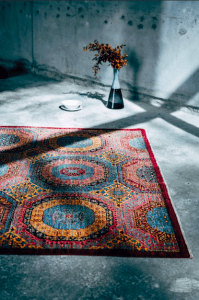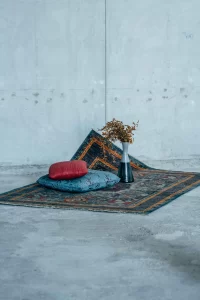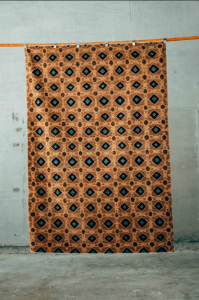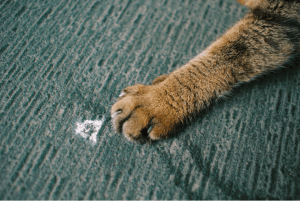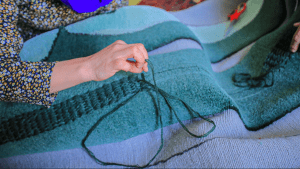In the living room of Beyoncé’s family estate in New York, an oil barrel recovered from a construction site in Tehran now sits next to a regal, eggplant-hued armchair. The barrel is no longer a perfect cylinder due to sizable dents acquired from its place of origin, yet despite the damage and discoloration, it’s an object that glows. Its blue-gray exterior has been glazed with a resin coating, and when observed from just the right angle, accents of gold flicker across its glossy patina surface. For Iranian artist Taher Asad-Bakhtiari, the man who transformed this industrial waste product into a thing of beauty, the barrel is a symbol of resilience and metamorphosis. It’s the story not only of his family’s tribe, but of all groups of people fighting for their right to exist in the face of destruction.
“I love taking things that don’t matter very much and giving them a purpose, a function, new life,” Asad-Bakhtiari tells of his creative process, which often requires bartering with construction workers in Tehran in order to obtain the barrels he turns into works of art. Though each resulting piece is unique, they carry the same message: “A person can come from nothing and eventually land somewhere so beautifully glorious that they could have never even imagined, and the barrels I make are kind of like that. I love that they come from nothing, but they can end up somewhere as amazing as Queen Bey’s house.”
The cross-continental journey of Beyoncé’s barrel is similar to Asad-Bakhtiari’s own path from Tehran to New York City. A self-proclaimed nomad of sorts, the artist – known as much for his recycled barrels as he is for his tribal-inspired tapestries – splits a lot of his time between both places. And when he’s not in either, expect to find him on the beach in Dubai, where he shares a house with his sister. The all-white interior of their villa serves as a stark backdrop for an eclectic decor scheme. Sentimental tableware, antique furniture, and heirloom textiles that the pair had sent over from Tehran are complemented by more abstract acquisitions, one of which was painted directly onto his dining room wall by Saudi Arabian artist Abdullah Qandeel. The modern space has an old-fashioned warmth to it, which is reflective of Asad-Bakhtiari’s inviting disposition, no matter which continent he’s on. “Dubai is home, Tehran is home, New York has been home for the past 10 years. They’re all different kinds of home,” he says, adding that he’s got his sights set on Paris next.
Even as his career takes him across the globe, Asad-Bakhtiari remains fiercely connected to his Iranian roots. He was born in Tehran in 1982 to a family of creatives and revolutionaries, including his great-aunt, the celebrated artist Monir Shahroudy Farmanfarmaian, and descendants of the Bakhtiari people, one of the most powerful indigenous tribes in his country’s history. This is the rich cultural heritage he explores across a variety of artistic mediums, most notably in the form of rugs and tapestries. Asad-Bakhtiari’s ongoing Tribal Weave Project, for example, is a thoughtful reimagining of the kilim and gabbeh rugs of his ancestors, whose craftsmanship is at risk of disappearing. It entails partnering with traditional weavers to preserve the fundamentals of these historic production techniques while stripping their creations down to reveal and celebrate the lace-like skeletons at their core.
“I’ve always gone against the grain,” he explains. “I don’t want people to see what I create and say, ‘OK, that’s a rug, let’s put it on the floor.’ I want people to think, ‘What is this?’. When I do things that allow people to question my creativity, that’s my aim.” This artistic philosophy has materialized in a diverse range of collaborations, including a collection of arrow-shaped runners for the Milan-based rug company cc-tapis, a series of commercial textile patterns for the US firm Bernhardt Design, and shows displaying his repurposed barrels for the Hostler Burrows design gallery, with whom he’s organizing another exhibition in Los Angeles next spring.
Most recently, Asad-Bakhtiari completed a rug commission for Side Gallery in Barcelona. The all-white piece is more functional than the bold aesthetic that’s earned him industry-wide acclaim in the past, though two of the artist’s signature touches make the commission identifiably his own: smaller warps exposing the construction of the weave, and a pattern of triangles that’s simple enough to let the craftsmanship take center stage. “When you look at a building, sometimes there are a lot of triangles that hold the building up. And for me, those triangles are what hold up my tapestries as well, and their lines and their borders,” he says. “It’s the foundation; it’s how I give my tapestry a solid ground so that I can strip down the other parts.”
The Side Gallery commission was produced in partnership with the Fatima Bint Mohamed Bin Zayed Initiative in Dubai, which was launched in 2010 to support women and children in Afghanistan by setting up employment opportunities in the arts and agriculture industries. Since its inception, FBMI has hired more than 8,000 predominantly female artisans, many of whom are widows. Asad-Bakhtiari has been involved in these efforts for five years, and credits the program with fostering a creative environment in which he can continue to evolve his craft while honoring and empowering the female artisans who inspire it. Lately, that has meant tapping into the expertise of Afghani women to experiment with fibers like copper. And this, he affirms with enthusiasm, is only the beginning. “Up until now, I’ve been kind of playing with crayons. But it’s time for me to expand into other things as well,” Asad-Bakhtiari says, describing his collaboration with these weavers as a two-way street for innovation. “The more both sides understand each other and understand the vision, the more it can expand your entire world.”

